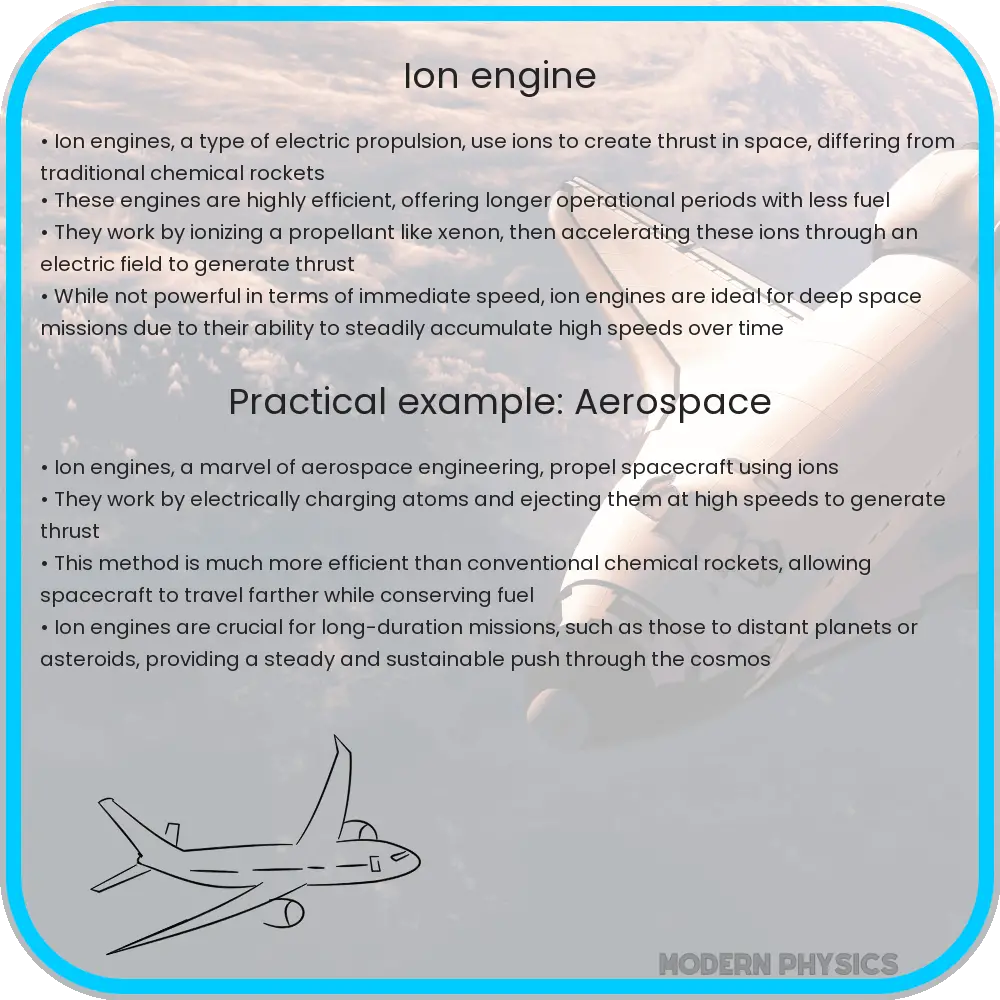Explore the revolution in space exploration with ion engines, offering high efficiency, low fuel use, and extended mission durations for deep space exploration.

Exploring Ion Engines: Revolutionizing Space Propulsion
Ion engines, a type of electric propulsion system, have emerged as a transformative technology in space exploration. Distinguished by their efficient fuel use and high thrust-to-weight ratio, these engines offer a promising alternative to conventional chemical propulsion methods. Ion propulsion systems utilize electricity, often generated by solar panels, to ionize a propellant like xenon, creating charged particles. These ions are then accelerated by electric fields to produce thrust, propelling spacecraft forward.
Advantages of Ion Propulsion
- Efficient Fuel Consumption: Ion engines operate on the principle of accelerating ions to extremely high velocities, far greater than that achievable by traditional chemical engines. This efficiency translates into a significant reduction in fuel requirements, enabling spacecraft to carry less propellant and more scientific instruments or other payloads.
- Extended Mission Durability: The low fuel consumption and efficient thrust generation of ion engines extend the operational life of space missions. These engines can function for years, as opposed to the limited burn time of chemical rockets, making them ideal for deep space exploration and long-duration missions.
- High Thrust-to-Weight Ratio: Despite their relatively low thrust output in absolute terms compared to chemical rockets, ion engines achieve a high thrust-to-weight ratio over time. This characteristic is crucial for gradually accelerating spacecraft to incredibly high speeds, enabling missions to reach distant targets in the solar system more swiftly.
Operational Principle of Ion Engines
The core mechanism of an ion engine involves ionizing a propellant gas, such as xenon, by stripping electrons from atoms, creating positive ions. These ions are then accelerated through an electrically charged grid to high speeds, generating thrust. The expelled ions produce a gentle yet continuous force, gradually increasing the spacecraft’s velocity over time. This process can be represented by the chemical formula for ionization, where Xe becomes Xe+ + e–, demonstrating the transformation of xenon atoms into positively charged ions and free electrons.
Ion engines represent a leap forward in propulsion technology, offering efficiency, longevity, and the potential for exploration far beyond what is currently achievable with conventional propulsion systems. Their continued development and integration into space missions promise to unlock new horizons in our quest to explore the cosmos.
Challenges and Future Prospects
Despite the considerable advantages of ion propulsion, there are challenges that need to be addressed. One significant issue is the initial low thrust, which means ion engines are not suitable for launching spacecraft from Earth’s surface. Instead, they are used once the spacecraft is already in space. Additionally, the reliance on high-voltage electricity to ionize propellant and generate thrust necessitates robust power sources, making solar panels or nuclear power essential for deep space missions.
Future advancements in ion propulsion technology are focused on increasing efficiency, reducing power requirements, and enhancing thrust capabilities. Research is underway to explore alternative propellants and more effective ionization methods. These innovations aim to make ion engines more versatile, potentially opening the door for their use in a wider range of missions, including manned spaceflights and interplanetary transport systems.
Impact on Space Exploration
The adoption of ion propulsion systems has already made a significant impact on space exploration. Missions such as NASA’s Dawn spacecraft, which explored the asteroid belt, and the Japanese Aerospace Exploration Agency’s Hayabusa missions, which returned samples from asteroids, have demonstrated the practical benefits of ion engines. These missions could achieve extended duration and maneuverability that would be impossible with traditional propulsion methods.
Conclusion
Ion engines are at the forefront of revolutionizing space propulsion. With their efficient fuel usage, high thrust-to-weight ratio, and capability for extended mission durations, they offer a promising solution to the limitations of conventional chemical rockets. While challenges such as low initial thrust and the need for substantial electrical power remain, ongoing research and technological advancements continue to enhance their performance and applicability. As ion propulsion technology matures, it will undoubtedly play a pivotal role in future deep space exploration missions, potentially making the vast expanse of our solar system and beyond more accessible than ever before.
The journey of ion propulsion from a theoretical concept to a key enabler of modern space exploration underscores the importance of innovation and perseverance in the quest to explore the unknown. As we stand on the brink of a new era in space travel, ion engines illuminate the path forward, driving humanity’s boundless curiosity to the far reaches of the cosmos.
